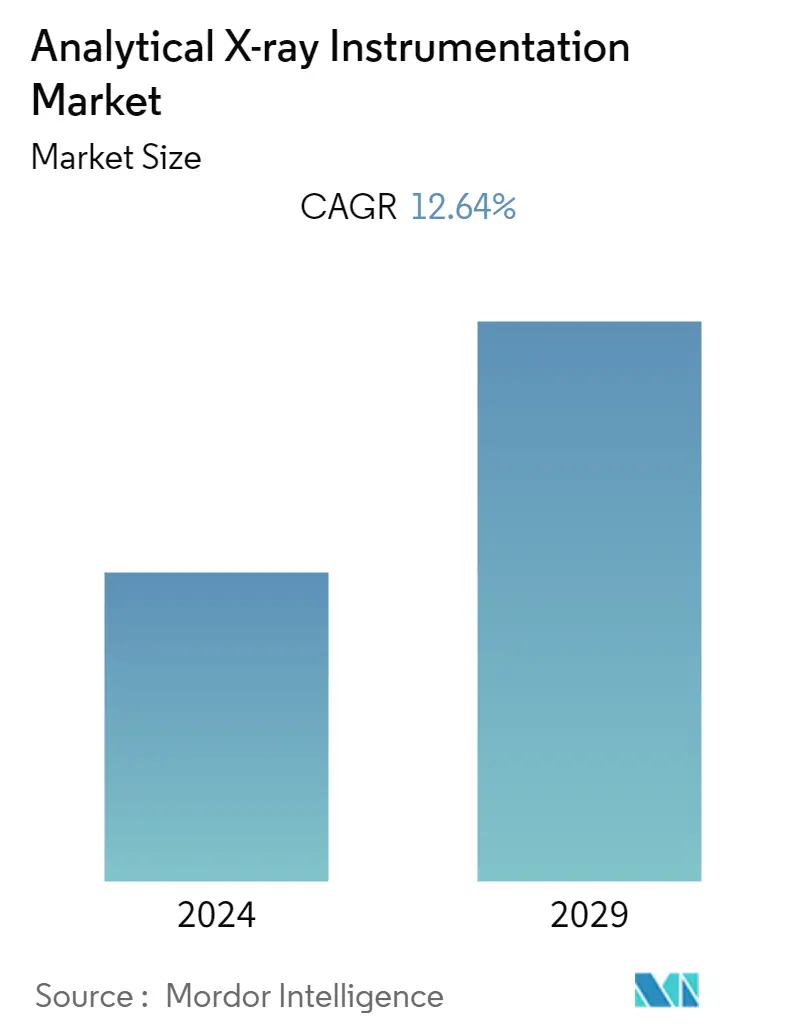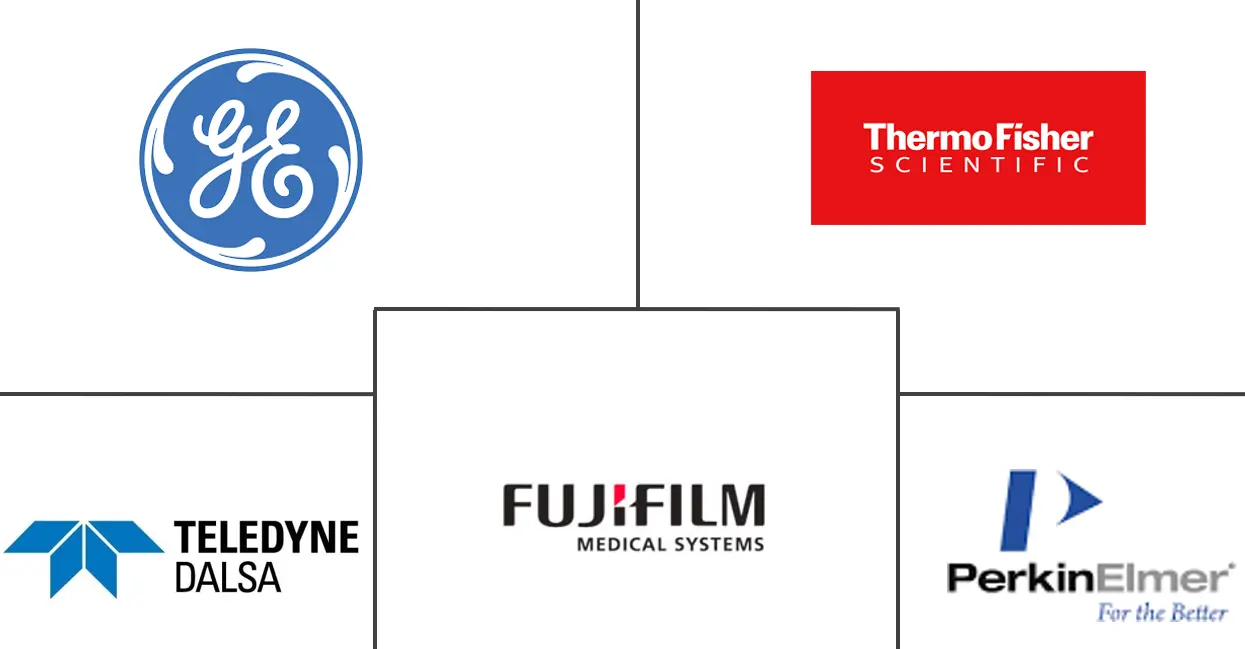Market Size of Analytical X-ray Instrumentation Industry

| Study Period | 2019 - 2029 |
| Base Year For Estimation | 2023 |
| CAGR | 12.64 % |
| Fastest Growing Market | Asia-Pacific |
| Largest Market | North America |
| Market Concentration | Low |
Major Players
*Disclaimer: Major Players sorted in no particular order |
Analytical X-ray Instrumentation Market Analysis
The analytical X-ray instrumentation market is expected to register a CAGR of 12.64% over the forecast period. X-rays have found applications in security, metallurgy, non-destructive testing, and other industrial applications. Technological advancement is one of the primary factors driving the growth of the market studied. The application of X-rays has drastically expanded beyond the field of medicine over the past few decades.
- There have been several technological advances in digital X-rays. For example, wireless and mobile X-ray systems allow healthcare practitioners to examine a patient at their bedside when they cannot be moved to the radiology room.
- Digital x-rays have become important in the field of dental science, helping dentists diagnose dental problems. The most recent development is the introduction of portable x-rays. Portable X-rays, such as home X-rays, help frail patients avoid hazardous hospital trips. These advancements have been catering to the significant demands in the market by making it easier for the patient to undergo clinical procedures.
- The development of low-energy X-ray systems has increased their use in various application areas. The applications of X-rays in security applications have increased considerably over the past few years. Baggage and personal scanners augment the deployment of X-ray tubes for object detection. Innovations in technology have facilitated the manufacturing of high-power X-rays, which are used in quality control systems in various industries.
- Technological advancements in the X-ray tube dimensions and new and enhanced imaging techniques based on X-rays are being introduced in the market. These technological breakthroughs have assisted the development of new X-ray tubes that can make the overall processes more efficient and can significantly enhance accuracy in numerous applications. The trend toward smaller and more densely populated electronics components and the emergence of micro-electromechanical systems (MEMS) and micro opto electromechanical systems (MOEMS) led to the development of nano-focus X-ray technology.
- However, high initial costs and stringent regulations are adding significant challenges to the studied market. Manufacturers of X-ray imaging equipment must follow the current electronic product radiation control (EPRC) regulations and procedures or offer a declaration of conformity to the equivalent International Electrotechnical Commission (IEC) standard. FDA has determined that industry conformance to certain IEC standards would offer, at a minimum, the same level of protection of public health and safety from electronic radiation as certain EPRC regulatory standards.
- After COVID-19, WHO laid out standard specifications for mobile radiographic digital equipment. The mobile radiographic equipment consists of multiple components, such as an X-ray generator, an X-ray tube, a tube telescopic arm support, etc. The equipment should have an X-ray tube support with a telescopic arm. The tube stand must be fully counterbalanced for rotation in all directions. The standards for product performance included IEC 60336:2005 X-ray tube assemblies for medical diagnosis. This is expected to further drive the market studied.
Analytical X-ray Instrumentation Industry Segmentation
The scope of the study includes the application of analytical X-ray systems in medical applications, with the prominent industries in the scope being manufacturing, healthcare, food, aerospace and defense, and other end-user industries, comprising government, security, and research and development labs in different geographies. The market sizes and forecasts are provided in terms of value (USD million) for all the above segments.
The study also tracks the key market parameters, underlying growth influencers, and major vendors operating in the industry, which supports the market estimations and growth rates during the forecast period. The study analyzes the impact of the COVID-19 pandemic on the ecosystem.
| By Component Type | |
| X-ray Tube | |
| X-ray Detectors | |
| Monochromatic |
| By End User | |
| Healthcare | |
| Manufacturing | |
| Food | |
| Aerospace and Defense | |
| Other Applications |
| By Application | |
| General Radiography | |
| Chest Imaging Application | |
| Cardiovascular Imaging | |
| Dental Applications |
| By Geography | |
| North America | |
| Europe | |
| Asia-Pacific | |
| Rest of the World |
Analytical X-ray Instrumentation Market Size Summary
The analytical X-ray instrumentation market is poised for significant growth, driven by technological advancements and expanding applications across various sectors. X-rays are increasingly utilized beyond medical fields, finding applications in security, metallurgy, and non-destructive testing. Innovations such as wireless and mobile X-ray systems have enhanced their utility in healthcare, allowing for bedside examinations and reducing the need for patient transfers. The development of portable and low-energy X-ray systems has further broadened their application scope, particularly in security and quality control. These advancements are supported by the trend towards smaller electronics and the emergence of nano-focus X-ray technology, which enhances measurement accuracy and efficiency. However, the market faces challenges from high initial costs and stringent regulatory requirements, necessitating compliance with international standards to ensure safety and efficacy.
In the medical sector, the demand for analytical X-ray systems is driven by the rising incidence of chronic diseases and the need for advanced diagnostic tools. The increasing geriatric population and the prevalence of conditions such as cancer have spurred the adoption of X-ray imaging technologies, including mammography and computed tomography. The market is characterized by moderate fragmentation, with key players like Varex Imaging Corporation, Thales Group, and Fujifilm Medical Systems leading the competitive landscape. Strategic investments and acquisitions, such as Canon Medical Systems' acquisition of Nordisk R√∏ntgen Teknik, are enhancing technological capabilities and expanding market reach. The growing demand for CT scanners, particularly in developing regions, is expected to further propel market growth, supported by innovations in X-ray tube technology and imaging solutions.
Analytical X-ray Instrumentation Market Size - Table of Contents
-
1. MARKET INSIGHTS
-
1.1 Market Overview
-
1.2 Industry Attractiveness - Porter's Five Forces Analysis
-
1.2.1 Bargaining Power of Suppliers
-
1.2.2 Bargaining Power of Consumers
-
1.2.3 Threat of New Entrants
-
1.2.4 Intensity of Competitive Rivalry
-
1.2.5 Threat of Substitutes
-
-
1.3 Assessment of COVID-19 Impact on the Industry
-
1.4 Industry Value Chain
-
-
2. MARKET SEGMENTATION
-
2.1 By Component Type
-
2.1.1 X-ray Tube
-
2.1.2 X-ray Detectors
-
2.1.3 Monochromatic
-
-
2.2 By End User
-
2.2.1 Healthcare
-
2.2.2 Manufacturing
-
2.2.3 Food
-
2.2.4 Aerospace and Defense
-
2.2.5 Other Applications
-
-
2.3 By Application
-
2.3.1 General Radiography
-
2.3.2 Chest Imaging Application
-
2.3.3 Cardiovascular Imaging
-
2.3.4 Dental Applications
-
-
2.4 By Geography
-
2.4.1 North America
-
2.4.2 Europe
-
2.4.3 Asia-Pacific
-
2.4.4 Rest of the World
-
-
Analytical X-ray Instrumentation Market Size FAQs
What is the current Analytical X-ray Instrumentation Market size?
The Analytical X-ray Instrumentation Market is projected to register a CAGR of 12.64% during the forecast period (2024-2029)
Who are the key players in Analytical X-ray Instrumentation Market?
GE Healthcare , Thermo Fisher Scientific Inc. , Fujifilm Medical Systems, Teledyne DALSA Inc. and PerkinElmer Inc. are the major companies operating in the Analytical X-ray Instrumentation Market.

